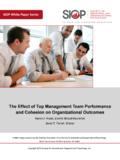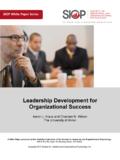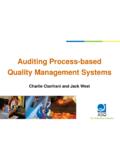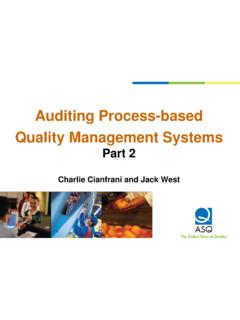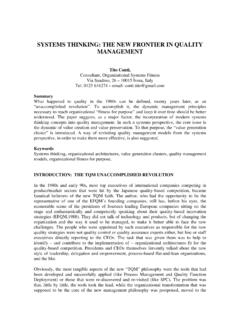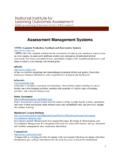Transcription of Encouraging Effective Performance Management Systems
1 Encouraging Effective Performance Management Systems Alison Carr, PhD candidate, Shaker Consulting Group Kelsey Kline, PhD, Organizational Development and Talent Management Consultant SIOP White Paper Series A White Paper prepared by the Visibility Committee of the Society for Industrial and Organizational Psychology. 440 E Poe Rd, Suite 101 Bowling Green, OH 43402 Copyright 2016 Society for Industrial and Organizational Psychology, Inc. 2 SIOP White Paper Series Table of Contents Authors .. 1 Background .. 4 Implications for Practice .. 5 Next Steps .. 7 References .. 9 3 SIOP White Paper Series Authors Kelsey Kline Organizational Development and Talent Management Consultant. Kelsey Kline earned her from the University of Akron. She currently works as an Organizational Development and Talent Management Consultant. Her re-search includes presentations and publications on Performance Management - with an emphasis on employee feedback and development - and employee health and well-being.
2 Alison Carr PhD candidate, University of Akron Alison Carr is a PhD candidate in I-O psychology at the University of Akron. She currently works as a consultant for Shaker Consulting Group, developing and re-fining high fidelity simulations for pre-employment assessments. Her research relates primarily to Performance Management (including issues surrounding max-imizing the impact of Performance feedback) and employee selection. 4 SIOP White Paper Series Implementation of a well-designed Performance Management (PM) system can strengthen an organization in numerous ways. Through the alignment of individual and organizational goals, PM Systems ad-vance strategic organizational objectives. High-quality PM Systems also improve work contributions of employees by offering increased opportunity and guidance for growth and development. In addition to fostering the acquisition of new skills ( , leadership competence) in order to improve job Performance (Aguinis & Kraiger, 2009), PM Systems improve hu-man capital in a number of key ways.
3 For example, PM Systems can increase employ-ee self-efficacy and empowerment and foster positive attitudes toward the organiza-tion by making employees feel valued and supported (Aguinis & Kraiger, 2009). This can in turn lead to improved Performance and employee willingness to go above and beyond their stated job duties. Organizations with systematic PM programs report su-perior financial results, customer satisfaction, and employee retention to (Nankervis & Compton, 2006). Not surprisingly, organizations utilizing PM Systems to invest in the professional development of employees (rather than simply to inform human capital decisions) often have competitive advantages in terms of attracting and retaining top industry talent. When PM is done well, it leads to many desirable results. However, poorly designed PM Systems can easily cause more harm than good. Given the stakes of PM administration, it is imperative that care is taken in the development and deployment of an organization s PM system .
4 A thoughtfully designed and implemented system allows for competitive ad-vantages, from the maintenance of a committed, strategically aligned, and well-developed talent pipeline to the ability to make legally defensible and data-driven human capital decisions. Where does your Performance Management system rate? We ll help you answer this question, and regardless of the answer, we will present some best prac-tices that can help you improve. Background PM is a continuous process including identification, measurement, and development of Performance in order to meet strategic goals of the organization. Perspectives on PM have changed drastically in the last decade. Organizations have moved from mid-year and end of year reviews to seeing PM as an ongoing process, only one component of which is the implementation of discrete, formal Performance feedback sessions (London & Smither, 2002). Expanding beyond the traditional annual Performance re-view, ongoing growth (or maintenance of good Performance ) has become a primary concern and places individual Performance more broadly in the context of organiza-tional Performance (Bernardin, Hagan, Kane, & Villanova, 1998).
5 Like other areas 5 SIOP White Paper Series within the talent Management space ( , coaching) the stigma that was once asso-ciated with devoting extra time and attention to growing and developing employees is rapidly diminishing. In fact, employees are seeking out professional development activities, and when they feel they are missing in an organization, many decide to leave (Morea, 2011). Effectiveness of a PM program is dependent on the strength of design and imple-mentation methods. A system lacking in appropriateness (of design, implementation, documentation, or user accountability) will not only fail to improve employee perfor-mance but may actually harm the organization. Poor system implementation can re-sult in legal ramifications, undesirable employee perceptions and behaviors ( , burnout, job dissatisfaction, turnover), and lost opportunities for enhancing productivi-ty (Aguinis, 2009).
6 Of further note, employees today are increasingly likely to follow self-guided career paths not organizationally bound career paths. As allegiance to the organization be-comes less of a deciding factor in whether an employee stays or leaves to work for a competitor, companies must increase efforts to retain talent. Effective PM increases employee perceptions of opportunities and support for advancement within the com-pany (Ready, Hill, & Conger, 2008). Thus, in addition to providing a competitive ad-vantage in market Performance , effectively designed and implemented PM Systems can offer organizations competitive advantages in terms of attracting and retaining top industry talent. Although details of the ideal PM system will vary from organization to organization, a num-ber of best practices for PM have been identified. Some of these are described below. Implications for Practice For many organizations, the necessary steps to PM will be familiar (Aguinis, 2009; see Figure 1).
7 The first step in the process is collaborative Performance planning. The employee and his/her manager must discuss and agree on what measurable re-sults or outcomes will be examined at the conclusion of a PM cycle (Step 1). Next, a development plan that outlines mutual expectations for Performance in the coming year should be created (Step 2). Once a plan is in place, the employee is expected to actively work toward goals over the agreed-upon period of time, and the manager should regularly observe Performance and progress (Step 4). Along with regular ob-servation, managers should provide feedback, reinforcement, and resources to sup-port growth (Step 5). When the rating period concludes, both the employee and su-pervisor should independently assess the extent to which goals were met and/or be-havior changed. This should include objective measurement where possible (Step 5). The final step in the cycle is the Performance review discussion, in which employee and supervisor meet to review progress.
8 The discussion should include honest and straightforward feedback and should address the past (what has been done and how), the present (outcomes of the past, such as Performance -based bonuses), and the future (setting goals for the next PM cycle; Aguinis, 2009). This PM cycle should be continuous, so the next steps are to repeat the process. 6 SIOP White Paper Series If your organization does not follow the process outlined above, the first step is to consider your current PM activities and see where you may need to adjust them to facilitate goal setting, development planning, and Performance feedback conversa-tions. If your organization is ready to take these practices to the next level, we pro-vide recommendations in four critical areas. First, be sure to establish strategic alignment. PM should always begin with the alignment of the objectives of individual jobs with the organization s overall strategic goals and direction.
9 This strategic alignment reinforces the ability of employees to engage in behaviors that promote attainment of the organization s strategic goals. Second, ensure collection of complete and accurate Performance ratings. Compre-hensive, valid, and reliable evaluation of an employee s level of Performance is a vi-tal component of Effective PM. Performance assessment serves as the foundation Figure 1. The Performance Management Process (developed from Aguinis, 2009) 7 for determining whether employees successfully attain goals and for identifying devel-opment areas. The validity and quality of Performance data drives the quality of deci-sions made from the PM process ( , compensation and promotions). A few key sug-gestions with regard to Effective Performance ratings are (a) ensure that the definitions of Effective and ineffective Performance are clear and aligned to organizational perfor-mance goals; (b) carefully define and measure Performance with regard to relevant tasks and competencies; and (c) ensure managers have the necessary resources ( , rater training, time to complete evaluations) to conduct Performance appraisals well and in a reasonably timely fashion.
10 Third, optimize feedback delivery. It is critical that Performance feedback is delivered appropriately. Although formal feedback is very useful, feedback should not be limited to official occasions. A good PM program requires availability of high-quality, informal feedback on a regular basis. To optimize feedback, providers should do the following: (a) emphasize its developmental usefulness; (b) focus on tasks as opposed to people, as this makes the feedback easier to understand and accept; (c) be trained to handle emotional responses from employees in order to facilitate deeper processing of the information; and (d) encourage two-way communication, because allowing the employ-ee to express his/her thoughts and opinions strongly relates to intentions to use the feedback (Cawley, Keeping, & Levy, 1998). Finally, leverage data wisely. PM Systems can also serve important organizational maintenance functions.
